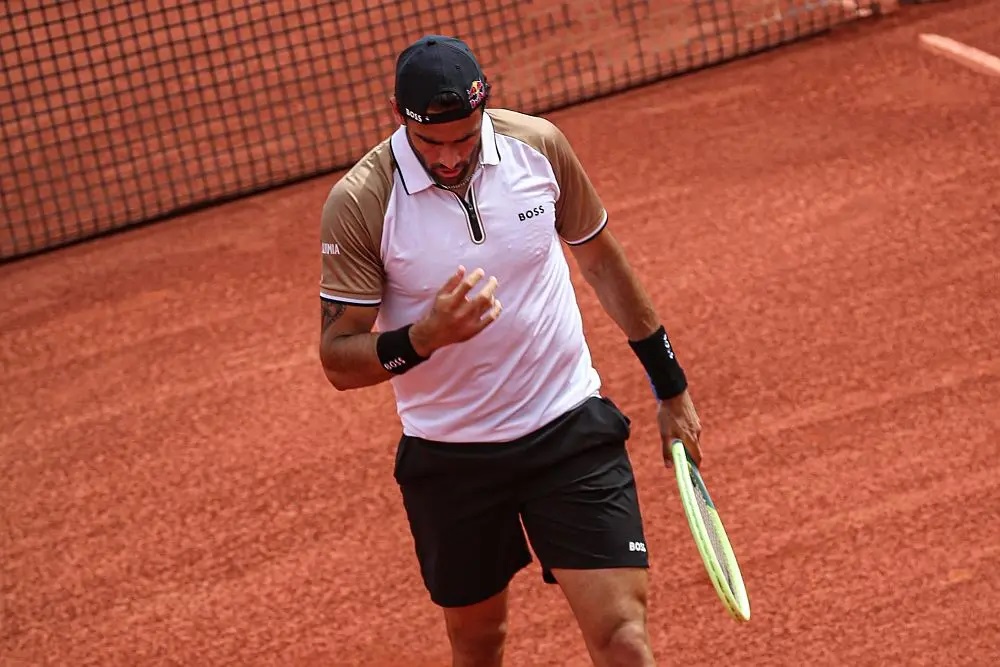Matteo Berrettini defeats Roberto Carballes Baena in straight sets, 75 62, and proves that his comeback is well grounded
If life is often considered a continuous narrative, it may be no coincidence that today Matteo Berrettini’s comeback journey intersescted Carballes Baena, a player he had faced twice in straight tournaments, Florence and Naples in October 2022, shortly before plunging into his annus horribilis, an injury-plagued 2023.
Just like resuming the story from where it was left.
Carballes Baena, the defending champion, got off to a sharper start, holding serve with ease and earning a first break point in the second game. Berrettini averted the threat by hammering down three serves but lost his service two games later.
Doubts on the Italian’s recovery from his energy-draining semifinal may have been starting to come afloat. However Berrettini broke back immediately, unsettling the Spaniard’s consistency with changes of pace and alternating lifted and sliced backhands.
The next six games neatly followed serve. Figures witness how close the match was. After 45 minutes the scoreboard read 5 games all, and stats reported 27 points apiece.
The eleventh game was to be crucial. Carballes Baena netted two forehands, while trying to hit through the Italian’s skidding spins and conceded a break point. Berrettini followed up two massive forehands with a delicate, unreachable drop shot and secured the break.
Carballes Baena was far from discouraged, and fired two forehand winners dashing to 0 40 with the Italian serving for the set.
Berrettini was lucky to save the first break point with a forehand that pinched the top of the net, and trickled over. Then he hit two winning first serves to draw even. Then again two first serves paired with their loyal forehand winner: Berrettini’s copyright gamepattern sealed a 59 minute first set.
The match seemed about to swing round at the very start of the second set when Carballes Baena had three break points and was winning all the longer rallies. Once more Berrettini got out of trouble thanks to his serve. Carballes Baena’s disappointment turned into frustration after he failed to put away two quite comfortable smashes and lost his service immediately after.
Unforced errors were seeping into the Spaniard’s game and when Berrettini won a 16-shot rally with a stunning crosscourt forehand on the stretch and went on to grab a two-break lead, the match appeared to have taken its final twist.
Berrettini did not falter when serving for the match at 5 2, despite an unforced error on the first point. Three first serves chauffeured him to two match points.
Carballes Baena only succeeded in bravely saving the first, well steering the rally. But the 2021 Wimbledon finalist produced a massive serve out wide and joyfully lifted his arms to the sky, for a most emotional victory. It means so much to a player whose talent and career have been incessantly diminished by injuries.
“It’s been a tough last couple of years” Matteo Berrettini said, holding the trophy. “Thanks to my team I was able to overcome all the tough moments my body didn’t allow me to play. I thank you and all the people that made my comeback possible: all my friends and my family, the people that were with me all the time when I was sad, injured and I didn’t think I could make it.”

 Latest news3 days ago
Latest news3 days ago
 ATP3 days ago
ATP3 days ago
 Focus1 day ago
Focus1 day ago
 Latest news2 days ago
Latest news2 days ago
 Hot Topics2 days ago
Hot Topics2 days ago
 Hot Topics19 hours ago
Hot Topics19 hours ago
 Hot Topics2 days ago
Hot Topics2 days ago
 Latest news2 days ago
Latest news2 days ago





























